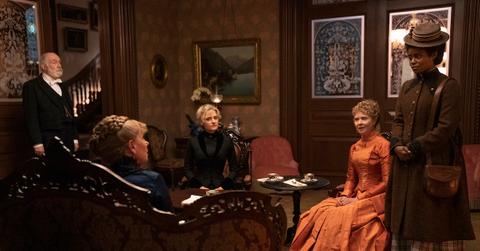The Gilded Age Was a Deceptive Period of Bounty, Wealth, and Rebellion
Published Jan. 24 2022, 1:00 p.m. ET

There’s nothing better than sitting down with a glass of wine and watching a classic period drama. Luckily, the writers of Downton Abbey are bringing us The Gilded Age on HBO, so we’ll get a peek into the American side of aristocracy during what was known as the Gilded Age.
Starring Christine Baranski and Cynthia Nixon, the new series explores many similar themes of the class struggle that are in Downton Abbey through a new lens.
But what exactly was the Gilded Age? We learn a lot of history in school, and then forget it all once we take the tests. So here’s a refresher — whether to study for our next U.S. History exam or just to watch The Gilded Age with a little more context.
The Gilded Age was the period between the Civil War and the turn of the century.
Funnily enough, the era’s name came from a satirical novel by none other than Mark Twain titled, The Gilded Age: A Tale of Today, which mocks the era’s façade of wealth and prosperity, when in actuality, the lower classes were suffering worse than ever. America grew bountiful in the Gilded Age — there was a major boom in technology, industry, and travel.

On the flipside, however, this naturally led to greed and corruption. In a way, the Gilded Age is somewhat reminiscent of recent years in America. In fact, in the HISTORY website’s description of the era, “It was wealthy tycoons, not politicians, who inconspicuously held the most political power during the Gilded Age.” We can’t help but be reminded of lobbyists like the NRA and pharmaceutical companies that pull strings behind today’s policies as well.

But despite its opulent appearance with very public aristocrats, there was a lot of unrest and struggle for the working class during the Gilded Age, which is how Mark Twain came up with calling it “gilded” — representing something covered in gold to look lavish from the outside, but was actually made of something else underneath. So what significant events happened during the Gilded Age?
During the Gilded Age, many notable things happened, such as the end of the Industrial Revolution.
We may not remember the Gilded Age in its entirety, but we’re sure many of the era’s significant developments will ring a bell. For one, the Transcontinental Railroad was built in this period, allowing much easier travel and expansion across America. Plus, the Gilded Age is largely considered to be the end of the Industrial Revolution — by 1900, over 40% of the American population lived in cities.

This is the period in which America (and much of Europe) became urbanized. However, the infrastructure had a lot to catch up to, and immigrants who were willing to work long hours for little pay were forced into slums and less than ideal living situations. At the same time, the boom in factories provided more jobs for immigrants, so there was also a lot of immigration to America during this time.
However, railroad and factory tycoons took over, building their wealth on the shoulders of these immigrants. Because of this inequality, the “muckrakers” came to be — journalists who worked to uncover corruption and horrific labor practices. Some might remember books such as Upton Sinclair’s The Jungle and Jacob Riis’s How the Other Half Lives, which uncovered many of these labor inequities.

Thanks to the muckrakers who dug out the muck, the Gilded Age was also home to railroad strikes and labor unions, which are still key to workers’s rights today. But it was the failure of two major railroad companies that eventually led to the collapse of the Gilded Age. In 1893, a major depression struck, leading to the Gilded Age’s demise and the progressive presidency of Teddy Roosevelt.
The Gilded Age premieres on Jan. 24 at 9 p.m. EST on HBO.